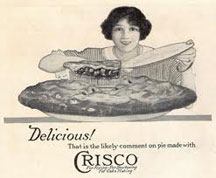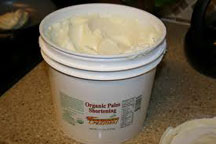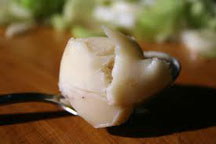Let's Go Back to Butter and Lard!
By Alice Osborne

On one of my favorite sites, Kelly the Kitchen Kop (www.KellyTheKitchenKop.com), I found some very interesting reading today. In her article, "How Crisco Demonized Lard and Butter," Kelly admits to having regularly cooked with Crisco® - who didn't? None of us knew better.
We know better now, and this is a topic that needs talking about often, so that this new generation of cooks doesn't make the same mistakes we older cooks made. Here, in Kelly's words, is a succinct explanation of how Crisco came about and pushed butter and lard off our pantry shelf:
 "Crisco was introduced to the public in 1911. It was an era when wives stayed home and cooked with plenty of butter and lard. The challenge for Crisco (made by Proctor & Gamble) was to convince the stay-at-home housewife about the merits of this imitation food. P&G's first ad campaign introduced the all-vegetable shortening as a healthier alternative to cooking with animal fats... and more economical than butter.' With one sentence, P&G had taken on its two closest competitors - lard and butter.
"Crisco was introduced to the public in 1911. It was an era when wives stayed home and cooked with plenty of butter and lard. The challenge for Crisco (made by Proctor & Gamble) was to convince the stay-at-home housewife about the merits of this imitation food. P&G's first ad campaign introduced the all-vegetable shortening as a healthier alternative to cooking with animal fats... and more economical than butter.' With one sentence, P&G had taken on its two closest competitors - lard and butter.
 "I remember switching from lard to Crisco to make pie crust when I was a teenager. We always used lard from the farm, but sometime in the 1960s, Mom innocently brought home our first can of Crisco. We started to use it liberally. That was the overt addition to the diet. What we didn't know was that Crisco and its cousins were being covertly added to countless food items.
"I remember switching from lard to Crisco to make pie crust when I was a teenager. We always used lard from the farm, but sometime in the 1960s, Mom innocently brought home our first can of Crisco. We started to use it liberally. That was the overt addition to the diet. What we didn't know was that Crisco and its cousins were being covertly added to countless food items.
 "We also didn't know that the partially hydrogenated oils in Crisco - the trans fatty acids - were bad for us. In fairness to P&G, they didn't know this either, not at first. But when reports of problems began to appear - problems like increased heart disease, increased cancer, growth problems, learning disorders and infertility - P&G worked behind the scenes to cover them up. One scientist who worked for P&G, Dr. Fred Mattson, can be credited with presenting the US government's inconclusive Lipid Research Clinics Trials to the public as proof that animal fats caused heart disease. He was also one of the baleful influences that persuaded the American Heart Association to preach the phony gospel of the Lipid Hypothesis.
"We also didn't know that the partially hydrogenated oils in Crisco - the trans fatty acids - were bad for us. In fairness to P&G, they didn't know this either, not at first. But when reports of problems began to appear - problems like increased heart disease, increased cancer, growth problems, learning disorders and infertility - P&G worked behind the scenes to cover them up. One scientist who worked for P&G, Dr. Fred Mattson, can be credited with presenting the US government's inconclusive Lipid Research Clinics Trials to the public as proof that animal fats caused heart disease. He was also one of the baleful influences that persuaded the American Heart Association to preach the phony gospel of the Lipid Hypothesis.
"But the truth about the dangers of trans fatty acids in foods like Crisco is finally emerging. Perhaps that is why P&G decided to put their flagship product up for sale."
So my question is always, "Well then, what SHOULD we cook and bake with?" Before I share Kelly's research, I have to admit that I've fallen for smooth marketing more than once. A good example is grapeseed oil - I've mentioned and even recommended it for cooking because of its high smoke point. Well, here's the issue with grapeseed oil: It's very high in omega-6 fatty acids, and we need to avoid excess omega-6 fatty acids as much as possible. Also, grapeseed oil is industrially processed with hexane and other carcinogenic solvents - traces of this stuff remain in the oil. While a product may possess one or two good qualities, other characteristics can cancel those one or two good things out? Such is the case with grapeseed oil.
Now back to Kelly the Kitchen Kop for researched advice on what's best to cook and bake with. She starts this particular article with "Warning: politically incorrect nutritional information just ahead..." and goes on to say she is going to be blunt:
"Please don't tell me you still have a tub of I Can't Believe It's Not Butter® in your kitchen? Or sticks of margarine? Or Promise® spread? They're not real food because of how processed they are, they contain trans fats: nasty hydrogenated or partially hydrogenated oils. (Even if they say, "Zero Trans Fats per Serving", check the ingredient label.) And if you don't find any trans fats, I guarantee they are made with vegetable oils.
 "For baking, I use non-pastured butter (organic) is always best, but any butter is better than the alternatives. By the way, do not soften it in the microwave. Plan ahead and set it out early to reach room temperature or use a saucepan to melt it. Microwaving changes its nutritional composition.
"For baking, I use non-pastured butter (organic) is always best, but any butter is better than the alternatives. By the way, do not soften it in the microwave. Plan ahead and set it out early to reach room temperature or use a saucepan to melt it. Microwaving changes its nutritional composition.
 "For higher heat frying, we use ghee (clarified butter - which means the milk solids are taken out as those are what can burn), bacon grease (from organic bacon that's minus the nitrates and nitrites), beef tallow (from range free beef) or lard.
"For higher heat frying, we use ghee (clarified butter - which means the milk solids are taken out as those are what can burn), bacon grease (from organic bacon that's minus the nitrates and nitrites), beef tallow (from range free beef) or lard.
 "For homemade salad dressings, I always use extra virgin olive oil (EVOO). If the EVOO has too strong a flavor for you, use it along with some peanut oil or sesame oil - these are OK as long as you're not eating too much of these monounsaturated oils. By the way, unless I'm using a lower heat, I don't generally fry with olive oil as the smoke point isn't high enough unless it's a more processed olive oil, which doesn't have as many nutrients left intact.
"For homemade salad dressings, I always use extra virgin olive oil (EVOO). If the EVOO has too strong a flavor for you, use it along with some peanut oil or sesame oil - these are OK as long as you're not eating too much of these monounsaturated oils. By the way, unless I'm using a lower heat, I don't generally fry with olive oil as the smoke point isn't high enough unless it's a more processed olive oil, which doesn't have as many nutrients left intact.
 "For sauteing, I also sometimes use the refined coconut oil (no taste or smell - not quite as good for you as the virgin, but much better than no coconut oil at all), unless I'm cooking something that a coconut flavor would go with, and then I use the virgin coconut oil. Ghee is good for this, too.
"For sauteing, I also sometimes use the refined coconut oil (no taste or smell - not quite as good for you as the virgin, but much better than no coconut oil at all), unless I'm cooking something that a coconut flavor would go with, and then I use the virgin coconut oil. Ghee is good for this, too.
 "For deep frying I love using lard or tallow. (If you can't find it locally, you can find a safe source of beef tallow online www.grasslandbeef.com, P.O. Box 9, Monticello, MO 63457, 877-383-0051. Shipping is free.) [Alice's note: You may feel free range meats and meat products, such as tallow, are pricey. Don't let cost deter you from eating what's best for your health - just eat less of it. Minimizing can make things more affordable.]
"For deep frying I love using lard or tallow. (If you can't find it locally, you can find a safe source of beef tallow online www.grasslandbeef.com, P.O. Box 9, Monticello, MO 63457, 877-383-0051. Shipping is free.) [Alice's note: You may feel free range meats and meat products, such as tallow, are pricey. Don't let cost deter you from eating what's best for your health - just eat less of it. Minimizing can make things more affordable.]
"Be sure to watch your smoke point - frying in too high a temp can cause free radicals (cancer causing) to go wild in our bodies. (This is also why you shouldn't eat fried foods in restaurants. You never know what oil they're using.)
 "For popcorn, I use full flavor organic virgin coconut oil (it's SO good for the body).
"For popcorn, I use full flavor organic virgin coconut oil (it's SO good for the body).
 "If I have a recipe that calls for shortening (I don't have many, maybe a homemade pie crust or biscuits) then use Organic Palm Shortening or softened butter.
"If I have a recipe that calls for shortening (I don't have many, maybe a homemade pie crust or biscuits) then use Organic Palm Shortening or softened butter.
 "For frying eggs or pancakes, or other things that a bacon flavor would be a compliment, use bacon grease. Try to get bacon from a local farm where we know the animals are raised well."
"For frying eggs or pancakes, or other things that a bacon flavor would be a compliment, use bacon grease. Try to get bacon from a local farm where we know the animals are raised well."
You can see why Kelly offered the warning at the start of her article: These recommendations truly aren't politically correct, and go against all the popular media marketing that bombards us. Her final suggestion, mine as well, is to do your own research and decide what will be best for your particular health issues - it's all out there. Then start making simple changes - eliminating the Crisco® (and other trans fats) would be the best place to start.
Sources:
www.kellythekitchenkop.com
www.cheeseslave.com
www.store.honoredprairie.com
www.purityfarms.com
www.psmomreviews.blogspot.com
www.latourangelle.com
www.grasslandbeef.com
www.mkokpelli.blogspot.com
www.penandfork.com

